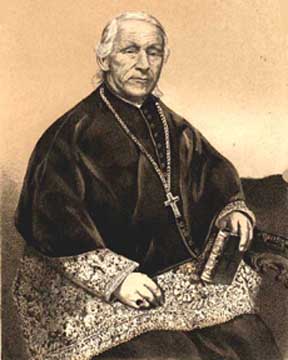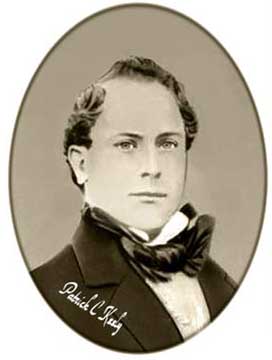St. Joseph's Cathedral - Table of Contents
![]()
St. Joseph's Cathedral - Table of Contents
History
- St. Joseph's RC Cathedral
AKA
St. Joseph's RC Old Cathedral
50 Franklin
St., Buffalo, NY
|
St.
Joseph RC Cathedral - Official Website |
|
Erected: |
1851-1855 Tower: 1862 Parish House: 1875 |
|
Architect: |
Patrick Keely |
|
Style: |
Gothic Revival |
|
Renovated: |
1976- 1977, Trautman Associates |
|
Status: |


|
Reprint
Bishop Timon and St. Joseph's Cathedral Second Looks: A Pictorial History of Buffalo and Erie County, by Scott Eberle and Joseph A. Grande. Donning Co., 1993 On April 23, 1847, the Roman
Catholic Diocese of Buffalo was established, and John Timon was
appointed its first bishop. |
|
Reprint
Bishop Timon and Immigrant Catholics in Buffalo "High Hopes: The Rise and Decline of Buffalo, New York." by Mark Goldman [In 1847] Pope Pius IX had created
the diocese of Western New York and had appointed John Timon of
Pennsylvania as the first bishop of Buffalo. |
|
Reprint
Bishop Timon Arrives in Buffalo Buffalo: Lake City in Niagara Land, by Richard C. Brown and Bob Watson. USA: Windsor Publications, 1981 On April 23, 1847, the Pope saw
fit to create the Diocese of Buffalo. later that year, the Right
reverend John Timon arrived in town as the first bishop of the new
diocese. |
|
Reprint
St. Joseph's Cathedral "The Cathedral of St. Joseph, Buffalo, New York" pamphlet When the first bishop of Buffalo, John Timon, came to Western New York in 1847, Catholics made-up less than 30% of the city's population, worshiping n small congregations scattered across the city and outlying towns. Timon traveled abroad. seeking and receiving financial assistance and gifts-in-kind from Pope Pius IX, European kings. and the religious faithful of many countries, including Mexico. Millard Fillmore, future president of the United States, also supported the endeavor financially. Four years passed from the groundbreaking for the cathedral in 1851 to its dedication in 1855, when more than 3,000 people gathered here in the midst of a torrential rainstorm (after a powerful storm destroyed several homes in the city in 1853, Bishop Timon ordered tents to be pitched inside the unfinished church so that families left homeless could take shelter here until their new homes were built). During construction of the cathedral, a stone mason was killed when he fell 70 feet from the scaffolding. On another occasion, work came to a standstill when the diocesan coffers ran dry. An accomplished linguist, Bishop Timon himself negotiated the gift of the great sanctuary windows, given by King Ludwig I of Bavaria. The windows won first prize at the Munich Exposition of 1854 in an exhibit sponsored by the king. Illustrating the birth, death, and resurrection of Christ, these were the first illustrated windows to be installed in the cathedral. Their rich and poignant imagery was especially important for the many uneducated people who came here to worship. On the advice of Pope Pius IX, the cathedral was dedicated to St. Joseph. A statue of St. Joseph was installed above the entrance in 1862. By 1863, the diocese had cleared its books of the$150,000 spent to build the cathedral. Free of debt, it could now be consecrated. bishop Timon presided over the ceremony, assisted by seven bishops and attended by hundreds of priests and thousands of lay people. With its pointed arches, ribbed vaulting, and elaborate ornamentation, the cathedral reflects the character of the 13th-century Salisbury Cathedral in England, with reminiscences of French and German Gothic as well. Clearly this influence grew from Keeley's tutelage under Augustus Pugin, who restored many English Gothic churches. Although original plans called for towers on the north and south ends of the facade, only the south tower was built, in 1862. In 1912, a new church at the corner of Delaware Ave. and Utica was planned for designation as the cathedral for the diocese by Bishop Charles, E. Colton. Plagued by serious flaws in design and construction, the New Cathedral was finally abandoned in 1977, at which time St. Joseph's Cathedral regained its status as the bishop's church. |
|
Reprint The Architecture of
St. Joseph's
Cathedral In contrast to Upjohn's highly
picturesque and historically accurate Gothic design for St. Paul's
Keeley's design for St. Joseph's represents the more symmetrical and
generalized Gothic common to mid-nineteenth-century Catholic churches. |
Page by Chuck LaChiusa in 2005| ...
Home Page ...| ..Buffalo Architecture Index...| ..Buffalo History Index... .|....E-Mail ...|
..
web site consulting by ingenious, in